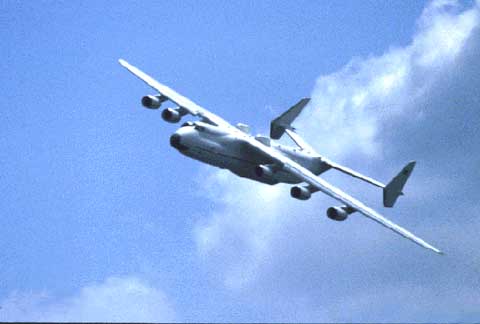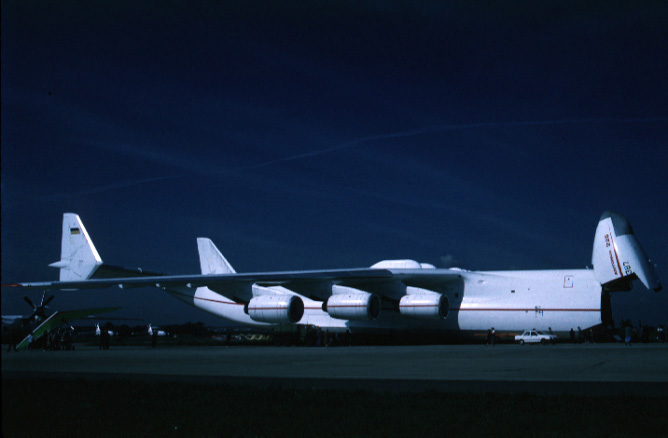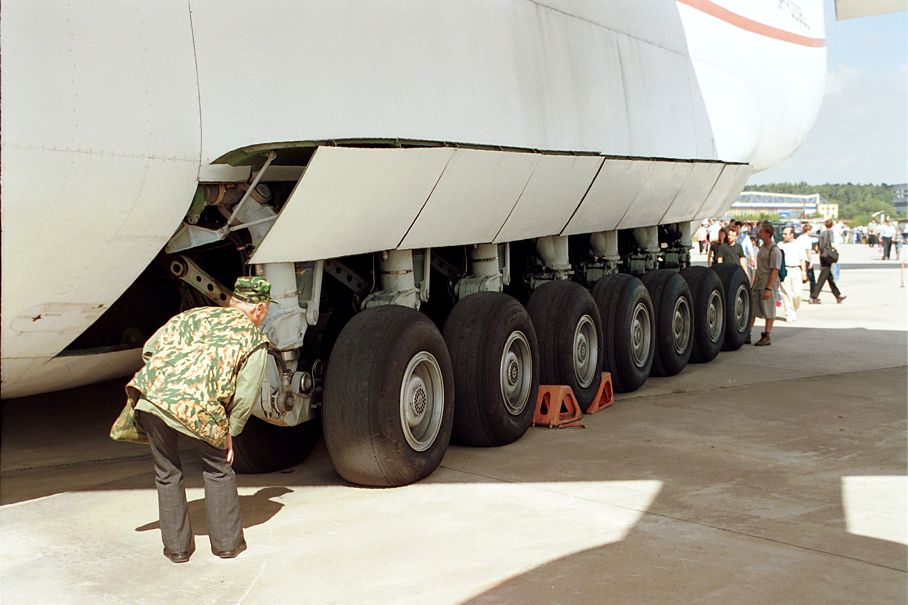Skip to comments.
The FReeper Foxhole Remembers The Bear River Massacre (1/29/1863) - Jan 29th, 2004
college.hmco.com ^
Posted on 01/29/2004 12:01:15 AM PST by SAMWolf
click here to read article
Navigation: use the links below to view more comments.
first previous 1-20 ... 61-80, 81-100, 101-120 ... 141-143 next last
To: SAMWolf
LOL You too, huh. I'm glad you posted this thread. It's still very interesting to read about history, however it occured.
81
posted on
01/29/2004 10:28:16 AM PST
by
Professional Engineer
(NASA bumper sticker: My other Rover is a FORD too.)
To: SAMWolf
That's just it, there's already another machine for him to use.
*snort*
I guess he just likes messing with mine.
(It has better sound.)
82
posted on
01/29/2004 10:30:49 AM PST
by
Darksheare
(Responsible for killing more threads than anyone else. Considered armed & weird. Use caution.)
To: Professional Engineer
Yep. We cover the good parts as well as the bad.
83
posted on
01/29/2004 10:31:52 AM PST
by
SAMWolf
(We secretly replaced the dilithium crystals with Folgers crystals...)
To: Darksheare
That makes it even worse. I finally password protected mine
84
posted on
01/29/2004 10:32:39 AM PST
by
SAMWolf
(We secretly replaced the dilithium crystals with Folgers crystals...)
To: SAMWolf
It is password protected.
But sometimes I have to leave it up and running because of a scan or something, and I'll be busy elsewhere.
That's when I end up finding out that someone was messing with my machine.
I've toyed with the idea of physically moving my machine to a room that I control access to.
But that's an extra 100 foot of network cable.
85
posted on
01/29/2004 10:50:17 AM PST
by
Darksheare
(Responsible for killing more threads than anyone else. Considered armed & weird. Use caution.)
To: Darksheare
But sometimes I have to leave it up and running because of a scan or something, and I'll be busy elsewhereSo far I've lucked out and everyone has stayed off mine.
86
posted on
01/29/2004 11:01:57 AM PST
by
SAMWolf
(We secretly replaced the dilithium crystals with Folgers crystals...)
To: SAMWolf
Lucky!
I'm extremely jealous!
I might have to start breaking fingers or worse.
87
posted on
01/29/2004 11:04:44 AM PST
by
Darksheare
(Responsible for killing more threads than anyone else. Considered armed & weird. Use caution.)
To: Darksheare

Be careful.
88
posted on
01/29/2004 11:08:56 AM PST
by
SAMWolf
(We secretly replaced the dilithium crystals with Folgers crystals...)
To: SAMWolf
*chuckle*
Somebody else's fingers..
89
posted on
01/29/2004 11:10:52 AM PST
by
Darksheare
(Responsible for killing more threads than anyone else. Considered armed & weird. Use caution.)
To: SAMWolf
Here's the actual panel from our B-200...:

90
posted on
01/29/2004 11:14:41 AM PST
by
Aeronaut
(In my humble opinion, the new expression for backing down from a fight should be called 'frenching')
To: Aeronaut
Hmmmm! You have a lot more "gadgets" in yours.
91
posted on
01/29/2004 11:18:18 AM PST
by
SAMWolf
(We secretly replaced the dilithium crystals with Folgers crystals...)
To: Aeronaut
OOOH! OOh! Digital insruments!
Cool!
(Analog backup, not the complete digital cockpit that some are advocating. I like!)
92
posted on
01/29/2004 11:31:48 AM PST
by
Darksheare
(Responsible for killing more threads than anyone else. Considered armed & weird. Use caution.)
To: snippy_about_it; All
SHOSHONI INDIANS
(Northwestern Bands)
At the time of major white penetration of the Great Basin and the Snake River areas in the 1840s, there were seven distinct Shoshoni groups. The Eastern Shoshoni, numbering about 2,000 under their famous Chief Washakie, occupied the region from the Wind River Mountains to Fort Bridger and astride the Oregon Trail. Their descendants today live on the Wind River Reservation. Two other divisions having similar cultures were the Goshute Shoshoni and the Western Shoshoni. The former, about 900 in number, lived in the valleys and mountains west and southwest of Great Salt Lake, with the remnants of their bands located in and around the small settlement of Ibapah, Utah, today. A much more numerous people, perhaps 8,000 strong, the Western Shoshoni occupied what is today northern and western Nevada. There were as many as eleven major bands distributed from the present Utah-Nevada border to Winnemucca on the west. Their descendants today live on the Duck Valley Reservation or scattered around the towns of northern Nevada from Wells to Winnemucca.
The four remaining groups of Shoshoni are usually listed under the general name of the "Northern Shoshoni." One of these groups, the Fort Hall Shoshoni of about 1,000 people, lived together with a band of about 800 Northern Paiute known in history as the Bannock at the confluence of the Portneuf and Snake rivers. A second division, the Lemhi, numbering some 1,800 people, ranged from the Beaverhead country in southwestern Montana westward to the Salmon River area, which was their main homeland. In western Idaho, along the Boise and Bruneau rivers, a third section of about 600 Shoshoni followed a life centered around salmon as their basic food. Finally, the fourth and final division of 1,500 people, the Northwestern Shoshoni, resided in the valleys of northern Utah--especially Weber Valley and Cache Valley--and along the eastern and northern shores of Great Salt Lake.
There were three major bands of Northwestern Shoshoni at the time the first Mormon pioneers began settling northern Utah. Chief Little Soldier headed the misnamed "Weber Ute" group of about 400, who occupied Weber Valley down to its entry into the Great Salt Lake. Chief Pocatello commanded a similar number of Shoshoni, who ranged from Grouse Creek in northwestern Utah eastward along the northern shore of Great Salt Lake to the Bear River. The third division of about 450 people, under Chief Bear Hunter, resided in Cache Valley and along the lower reaches of the Bear River. Bear Hunter was regarded as the principal leader of the Northwestern Shoshoni, being designated by Mormon settlers as the war chief who held equal status with Washakie when the Eastern and Northwestern groups met in their annual get-together each summer in Round Valley, just north of Bear Lake.
By the 1840s, the Northwestern Shoshoni had adopted most of the Plains Culture, using the horse for mobility and the hunting of game. Chief Pocatello especially led his band on numerous hunts for buffalo in the Wyoming area. Pocatello also gained notoriety as a reckless and fearless marauder along the Oregon and California trails. The Wasatch Mountains provided small game for the Northwestern bands, but of even greater importance were the grass seeds and plant roots which grew in abundance in the valleys and along the hillsides of northern Utah before the cattle and sheep of the white man denuded these rich areas and left many of the Shoshoni tribes in a starving condition and to suffer under the ignominy of being called "Digger Indians." Before white penetration, the Great Basin and Snake River Shoshoni had been among the most ecologically efficient and well-adapted Indians of the American West.
The tragic transformation for the Northwestern Shoshoni to a life of privation and want came with the occupation by Mormon farmers of their traditional homeland. The white pioneers slowly moved northward along the eastern shores of Great Salt Lake until by 1862 they had taken over Cache Valley, home of Bear Hunter's band. In addition, California-bound emigrants had wasted Indian food supplies as the travelers followed the Salt Lake Road around the lake and across the salt desert to Pilot Peak. The discovery of gold in Montana in 1862 further added to the traffic along the route. The young men of Bear Hunter's tribe began to strike back in late 1862, raiding Mormon cattle herds and attacking mining parties traveling to and from Montana.
The Indian aggression came to an end on 29 January 1863. On the morning of that day, Colonel Patrick Edward Connor and about 200 California Volunteers from Camp Douglas in Salt Lake City assaulted the winter camp of Bear Hunter's Northwestern group of 450 men, women, and children on Beaver Creek at its confluence with the Bear River, some twelve miles west of the Mormon village of Franklin in Cache Valley. As a result of the four-hour carnage that ensued, twenty-three soldiers lost their lives and at least 250 Shoshoni were slaughtered by the troops, including ninety women and children in what is now called the Bear River Massacre. Bear Hunter was killed, and the remnants of his tribe under Sagwitch and the chiefs of nine other Northwestern bands signed the Treaty of Box Elder at Brigham City, Utah, on 30 July 1863, bringing peace to this Shoshoni region.
After the signing of the Box Elder agreement, government officials attempted to get all of the Northwestern Shoshoni to move to the newly founded Fort Hall Indian Reservation in Idaho. After several years of receiving their government annuities at Corinne, Utah, near the mouth of the Bear River, the Indians bands finally gave up their homelands in Utah and settled at Fort Hall, where their descendants live today. As a result of their move to Idaho, the Northwestern Shoshoni have been lost to Utah history although for centuries they had lived in northern Utah. It is time for Utah historians to make the Shoshoni a prominent part of the state's history along with the Navajo, Paiute, and Ute tribes.
Brigham D. Madsen
93
posted on
01/29/2004 11:58:32 AM PST
by
SAMWolf
(We secretly replaced the dilithium crystals with Folgers crystals...)
To: SAMWolf
The Mormons certainly don't have a very pretty history when it comes to the Indians of the west.
94
posted on
01/29/2004 12:05:03 PM PST
by
snippy_about_it
(Fall in --> The FReeper Foxhole. America's History. America's Soul.)
To: snippy_about_it
No, they sure don't.
95
posted on
01/29/2004 12:05:48 PM PST
by
SAMWolf
(We secretly replaced the dilithium crystals with Folgers crystals...)
To: All
|
Air Power
Antonov An-225 "Mriya"
 |
There is nothing on Earth or in the air quite like the Antonov An-225. Dwarfing a Boeing 747 and out-lifting a U.S. Air Force C-5A Galaxy, it can haul an expeditionary force into combat, or carry enough food to avert a famine. Yet, oddly, the original purpose of the An-225 was neither hostile nor humanitarian. Conceived in the chilliest years of the Cold War, the plane was designed as an airborne tow truck for the now-defunct Soviet space shuttle program. Despite its lack of armaments, NATO war planners gave the An-225 a military code name, Cossack. History would reveal that the Soviet nickname for the An-225, Mriya, which is Ukrainian for "dream," was more apt.
In keeping with the Soviet penchant for building the world's biggest everything, the An-225 was designed to carry twice as much as a Boeing 747 freighter. The dimensions of the An-225 are staggering--nearly a football field from nose to tail and wingtip to wingtip. With a maximum takeoff weight of about 1.32 million pounds, it is 50 percent heavier than a fully loaded C-5A. To get so massive an aircraft into the sky, Ukrainian engineers equipped the An-225 with six ZMKB Progress Lotarev D-18T turbofan jets, each capable of pumping out 51,590 pounds of thrust.
After only 3-1/2 years in development, Mriya took its maiden voyage on Dec. 21, 1988. Less than a year later the Berlin Wall fell, and with its collapse the Soviet Union dissolved. Ukraine, home to the Antonov Design Bureau that created the An-225, split away as an independent republic. And with these changes the future of the An-225 changed as well.
Military Roots
As revolutionary as it appears, the An-225 is a derived rather than original aircraft. Basically, it is an enlarged version of the Antonov An-124 military transport. Engineers stretched this smaller plane nearly 40 ft. and added two engines. To distribute the weight of the fully loaded, 6-engine aircraft, the An-225 was equipped with an unusually configured 32-wheel landing gear. Normally, only the nose gear of an aircraft is steerable. On the An-225 there are 20 steerable wheels: four in the nose gear and 16 at the rear of the 28-wheel main gear. The result is an aircraft that is extremely maneuverable.
Making the An-225 equally agile in the air is the reason behind the plane's signature wide split-tail. While most of the An-225 follows the lines of the smaller An-124, the modified split-tail was added to maintain the plane's maneuverability when it carries large exterior loads.
Arriving In Style
The An-225 made its international debut in a style befitting its dimensions: by landing at the 1989 Paris Air Show with the Buran space shuttle on its back. Eight months earlier, on Nov. 15, 1988, the Soviet shuttle made history in its own right, with its one and only orbital flight, an unmanned mission in which it circled the Earth twice. Despite this success, the shuttle program was grounded for lack of funds, and formally discontinued in 1993. Without a mission, the need for the An-225 evaporated. The massive plane was parked outside its hangar near Kiev, its engines scavenged for parts.
With the breakup of the Soviet Union, the Antonov Group acquired the An-225 and began searching for a way to make the plane profitable. The An-225 boasts a payload of 551,150 pounds. What cannot fit inside can be put on its back. Objects as large as 33 ft. in diameter and 230 ft. long can be accommodated. Plus, it offers exceptional speed and range: The big jet cruises at nearly 500 mph and, fully loaded, it could fly nonstop from New York to Los Angeles. Armed with these impressive credentials, the Antonov Group found a business partner, Motor-Sich, the Ukrainian manufacturer that built the plane's engines. Together they invested the equivalent of $20 million to repair the An-225 and install modern avionics.
The first hint that the investment might pay off came on Jan. 2, 2002. The plane took off from Stuttgart, Germany, on its first commercial flight, hauling 216,000 prepared meals for American military personnel in the Persian Gulf. "Bookings range from general cargo to items of over 200 tons and pieces that would only fit on the roof," says a spokesman for Air Foyle HeavyLift, the company that hopes to put the An-225 into regular service.
There is an outside chance that an An-225 will play a role in the Russian space program, as a flying first stage of the proposed MAKS Space Plane, which could fly as early as 2006.
Meanwhile, the status of the An-225 is being challenged by the new Airbus A-380. Scheduled to fly in 2006, it boasts a takeoff weight of 1,235,000 pounds, a shade lighter than the An-225.
Specifications:
Manufactuer: Antonov
Primary Role: Cargo
Official Name: An-225, Mriya
Engines: Six ZMKB Progress Lotarev D-18T turbofans each producing 51,590 lb. of thrust
Crew: 7
Dimensions:
Wingspan: 290 ft.
Length: 275 ft. 7 in.
Height: 59 ft. 8-1/2 in.
Cargo Hold:
Length: 141 ft.;
Width: 21 ft.;
Height: 14 ft. 5-1/4 in.
Max Takeoff Weight: 1,322,750 lb.
Max Payload Weight: 551,150 lb.
Performance :
Cruising Speed: 497 mph
Max Speed: 528 mph
Range With Max Payload: 2813 miles
Range With Max Fuel: 9625 miles
Armaments:
None






All information and photos Copyright of their respective websites
96
posted on
01/29/2004 1:16:31 PM PST
by
Johnny Gage
(God Bless our Firefighters, our Police and our EMS responders)
To: Johnny Gage
Thanks Johnny. Ya think it has enough wheels?


97
posted on
01/29/2004 1:30:15 PM PST
by
SAMWolf
(We secretly replaced the dilithium crystals with Folgers crystals...)
To: snippy_about_it
There are sad stories in our history on every side. I guess the greatest of America is not that she is without sin, but that she is capable of recognizing her sin and addressing it.
98
posted on
01/29/2004 1:40:16 PM PST
by
Samwise
(There are other forces at work in this world, Frodo, besides the will of evil.)
To: SAMWolf
My power just came back on this afternoon after being out since Monday morning. We reall got hammered by the ice storm in South Carolina. I got a lot of catching up to do.
99
posted on
01/29/2004 1:49:40 PM PST
by
aomagrat
(IYAOYAS)
To: Johnny Gage
That's one huge plane!!! Thanks Johnny.
100
posted on
01/29/2004 1:53:14 PM PST
by
snippy_about_it
(Fall in --> The FReeper Foxhole. America's History. America's Soul.)
Navigation: use the links below to view more comments.
first previous 1-20 ... 61-80, 81-100, 101-120 ... 141-143 next last
Disclaimer:
Opinions posted on Free Republic are those of the individual
posters and do not necessarily represent the opinion of Free Republic or its
management. All materials posted herein are protected by copyright law and the
exemption for fair use of copyrighted works.
FreeRepublic.com is powered by software copyright 2000-2008 John Robinson










